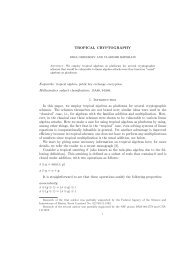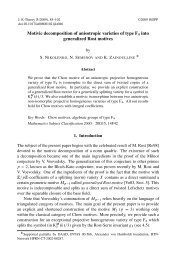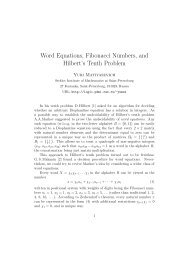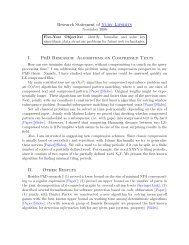Tree isomorphism
Tree isomorphism
Tree isomorphism
Create successful ePaper yourself
Turn your PDF publications into a flip-book with our unique Google optimized e-Paper software.
<strong>Tree</strong> <strong>isomorphism</strong><br />
Alexander Smal<br />
St.Petersburg State University of Information Technologies, Mechanics and Optics<br />
Joint Advanced Student School 2008<br />
1 / 22
Motivation<br />
In some applications the chemical structures are often trees with<br />
millions of vertices:<br />
∙ gene splicing,<br />
∙ protein analysis,<br />
∙ molecular biology.<br />
Difference between O(n), O(n log n), and O(n 2 ) <strong>isomorphism</strong><br />
algorithms is not just theoretical importance.<br />
2 / 22
Graph <strong>isomorphism</strong><br />
Definition<br />
Isomorphism of graphs G1(V1, E1) and G2(V2, E2) is a bijection<br />
between the vertex sets
Graph <strong>isomorphism</strong><br />
Definition<br />
Isomorphism of graphs G1(V1, E1) and G2(V2, E2) is a bijection<br />
between the vertex sets
Graph <strong>isomorphism</strong><br />
Definition<br />
Isomorphism of graphs G1(V1, E1) and G2(V2, E2) is a bijection<br />
between the vertex sets
Graph <strong>isomorphism</strong><br />
Definition<br />
Isomorphism of graphs G1(V1, E1) and G2(V2, E2) is a bijection<br />
between the vertex sets
Rooted trees<br />
Definition<br />
Rooted tree (V , E, r) is a tree (V , E) with selected root r ∈ V .<br />
4 / 22
Rooted trees<br />
Definition<br />
Rooted tree (V , E, r) is a tree (V , E) with selected root r ∈ V .<br />
Definition<br />
Isomorphism of rooted trees T1(V1, E1, r1) and T2(V2, E2, r2) is<br />
a bijection between the vertex sets
Rooted trees<br />
Definition<br />
Rooted tree (V , E, r) is a tree (V , E) with selected root r ∈ V .<br />
Definition<br />
Isomorphism of rooted trees T1(V1, E1, r1) and T2(V2, E2, r2) is<br />
a bijection between the vertex sets
Rooted trees<br />
Definition<br />
Rooted tree (V , E, r) is a tree (V , E) with selected root r ∈ V .<br />
Definition<br />
Isomorphism of rooted trees T1(V1, E1, r1) and T2(V2, E2, r2) is<br />
a bijection between the vertex sets
Rooted trees<br />
Definition<br />
Rooted tree (V , E, r) is a tree (V , E) with selected root r ∈ V .<br />
Definition<br />
Isomorphism of rooted trees T1(V1, E1, r1) and T2(V2, E2, r2) is<br />
a bijection between the vertex sets
Rooted trees (part 2)<br />
Lemma<br />
If there is O(n) algorithm for rooted trees <strong>isomorphism</strong>, then there<br />
is O(n) algorithm for ordinary trees <strong>isomorphism</strong>.<br />
5 / 22
Rooted trees (part 2)<br />
Lemma<br />
If there is O(n) algorithm for rooted trees <strong>isomorphism</strong>, then there<br />
is O(n) algorithm for ordinary trees <strong>isomorphism</strong>.<br />
Proof.<br />
1 Let A to be O(n) algorithm for rooted trees.<br />
5 / 22
Rooted trees (part 2)<br />
Lemma<br />
If there is O(n) algorithm for rooted trees <strong>isomorphism</strong>, then there<br />
is O(n) algorithm for ordinary trees <strong>isomorphism</strong>.<br />
Proof.<br />
1 Let A to be O(n) algorithm for rooted trees.<br />
2 Let T1 and T2 to be ordinary trees.<br />
5 / 22
Rooted trees (part 2)<br />
Lemma<br />
If there is O(n) algorithm for rooted trees <strong>isomorphism</strong>, then there<br />
is O(n) algorithm for ordinary trees <strong>isomorphism</strong>.<br />
Proof.<br />
1 Let A to be O(n) algorithm for rooted trees.<br />
2 Let T1 and T2 to be ordinary trees.<br />
3 Lets find centers of this trees. There are three cases:<br />
5 / 22
Rooted trees (part 2)<br />
Lemma<br />
If there is O(n) algorithm for rooted trees <strong>isomorphism</strong>, then there<br />
is O(n) algorithm for ordinary trees <strong>isomorphism</strong>.<br />
Proof.<br />
1 Let A to be O(n) algorithm for rooted trees.<br />
2 Let T1 and T2 to be ordinary trees.<br />
3 Lets find centers of this trees. There are three cases:<br />
1 each tree has only one center (c1 and c2 respectively)<br />
return A(T1, c1, T2, c2)<br />
5 / 22
Rooted trees (part 2)<br />
Lemma<br />
If there is O(n) algorithm for rooted trees <strong>isomorphism</strong>, then there<br />
is O(n) algorithm for ordinary trees <strong>isomorphism</strong>.<br />
Proof.<br />
1 Let A to be O(n) algorithm for rooted trees.<br />
2 Let T1 and T2 to be ordinary trees.<br />
3 Lets find centers of this trees. There are three cases:<br />
1 each tree has only one center (c1 and c2 respectively)<br />
return A(T1, c1, T2, c2)<br />
2 each tree has exactly two centers (c1, c ′ 1 and c2, c ′ 2<br />
respectively)<br />
return A(T1, c1, T2, c2) or A(T1, c ′ 1 , T2, c2)<br />
5 / 22
Rooted trees (part 2)<br />
Lemma<br />
If there is O(n) algorithm for rooted trees <strong>isomorphism</strong>, then there<br />
is O(n) algorithm for ordinary trees <strong>isomorphism</strong>.<br />
Proof.<br />
1 Let A to be O(n) algorithm for rooted trees.<br />
2 Let T1 and T2 to be ordinary trees.<br />
3 Lets find centers of this trees. There are three cases:<br />
1 each tree has only one center (c1 and c2 respectively)<br />
return A(T1, c1, T2, c2)<br />
2 each tree has exactly two centers (c1, c ′ 1 and c2, c ′ 2<br />
respectively)<br />
return A(T1, c1, T2, c2) or A(T1, c ′ 1 , T2, c2)<br />
3 trees has different number of centers<br />
return False<br />
5 / 22
Diameter and center<br />
Definition<br />
The diameter of tree is the length of the longest path.<br />
6 / 22
Diameter and center<br />
Definition<br />
The diameter of tree is the length of the longest path.<br />
Definition<br />
A center is a vertex v such that the longest path from v to a leaf<br />
is minimal over all vertices in the tree.<br />
6 / 22
Diameter and center<br />
Definition<br />
The diameter of tree is the length of the longest path.<br />
Definition<br />
A center is a vertex v such that the longest path from v to a leaf<br />
is minimal over all vertices in the tree.<br />
Algorithm<br />
1: Choose a random root r.<br />
2: Find a vertex v1 — the farthest form r.<br />
3: Find a vertex v2 — the farthest form v1.<br />
4: Diameter is a length of path from v1 to v2.<br />
5: Centers are median elements of path from v1 to v2.<br />
6 / 22
Diameter and center<br />
Definition<br />
The diameter of tree is the length of the longest path.<br />
Definition<br />
A center is a vertex v such that the longest path from v to a leaf<br />
is minimal over all vertices in the tree.<br />
Algorithm<br />
1: Choose a random root r.<br />
2: Find a vertex v1 — the farthest form r.<br />
3: Find a vertex v2 — the farthest form v1.<br />
4: Diameter is a length of path from v1 to v2.<br />
5: Centers are median elements of path from v1 to v2.<br />
It is O(n) algorithm.<br />
6 / 22
The idea<br />
Let’s try to find complete invariant of rooted trees <strong>isomorphism</strong>.<br />
7 / 22
The idea<br />
Let’s try to find complete invariant of rooted trees <strong>isomorphism</strong>.<br />
Definition<br />
Isomorphism invariant is a function f (T ) such that<br />
f (T1) = f (T2) for all pairs of isomorphic trees T1 and T2.<br />
7 / 22
The idea<br />
Let’s try to find complete invariant of rooted trees <strong>isomorphism</strong>.<br />
Definition<br />
Isomorphism invariant is a function f (T ) such that<br />
f (T1) = f (T2) for all pairs of isomorphic trees T1 and T2.<br />
Definition<br />
Complete <strong>isomorphism</strong> invariant is a function f (T ) such that<br />
two trees T1 and T2 are isomorphic if and only if f (T1) = f (T2).<br />
7 / 22
The idea<br />
Let’s try to find complete invariant of rooted trees <strong>isomorphism</strong>.<br />
Definition<br />
Isomorphism invariant is a function f (T ) such that<br />
f (T1) = f (T2) for all pairs of isomorphic trees T1 and T2.<br />
Definition<br />
Complete <strong>isomorphism</strong> invariant is a function f (T ) such that<br />
two trees T1 and T2 are isomorphic if and only if f (T1) = f (T2).<br />
So if we find complete <strong>isomorphism</strong> invariant we can obtain<br />
algorithm from it.<br />
7 / 22
The idea<br />
Let’s try to find complete invariant of rooted trees <strong>isomorphism</strong>.<br />
Definition<br />
Isomorphism invariant is a function f (T ) such that<br />
f (T1) = f (T2) for all pairs of isomorphic trees T1 and T2.<br />
Definition<br />
Complete <strong>isomorphism</strong> invariant is a function f (T ) such that<br />
two trees T1 and T2 are isomorphic if and only if f (T1) = f (T2).<br />
So if we find complete <strong>isomorphism</strong> invariant we can obtain<br />
algorithm from it.<br />
Note<br />
Starting from the next slide tree always means rooted tree!<br />
7 / 22
Candidate 1<br />
Observation<br />
The level number of a vertex is a tree <strong>isomorphism</strong> invariant.<br />
8 / 22
Candidate 1<br />
Observation<br />
The level number of a vertex is a tree <strong>isomorphism</strong> invariant.<br />
Conjecture<br />
Two trees are isomorphic if and only if they have the same number<br />
of levels and the same number of vertices on each level.<br />
8 / 22
Candidate 1<br />
Observation<br />
The level number of a vertex is a tree <strong>isomorphism</strong> invariant.<br />
Conjecture<br />
Two trees are isomorphic if and only if they have the same number<br />
of levels and the same number of vertices on each level.<br />
Observation<br />
The number of the leaves is a tree <strong>isomorphism</strong> invariant.<br />
8 / 22
Candidate 1<br />
Observation<br />
The level number of a vertex is a tree <strong>isomorphism</strong> invariant.<br />
Conjecture<br />
Two trees are isomorphic if and only if they have the same number<br />
of levels and the same number of vertices on each level.<br />
Observation<br />
The number of the leaves is a tree <strong>isomorphism</strong> invariant.<br />
Contrary instance<br />
T1<br />
a A<br />
1 2 · · · n 1 2 · · · n<br />
d e D E<br />
T2<br />
8 / 22
Candidate 2<br />
What’s wrong with candidate 1?<br />
We didn’t take into account the degree spectrum of a tree.<br />
9 / 22
Candidate 2<br />
What’s wrong with candidate 1?<br />
We didn’t take into account the degree spectrum of a tree.<br />
Definition<br />
Degree spectrum of tree is the sequence of non-negative integers<br />
{dj}, where dj is the number of vertices that have j children.<br />
9 / 22
Candidate 2<br />
What’s wrong with candidate 1?<br />
We didn’t take into account the degree spectrum of a tree.<br />
Definition<br />
Degree spectrum of tree is the sequence of non-negative integers<br />
{dj}, where dj is the number of vertices that have j children.<br />
Conjecture<br />
Two trees are isomorphic if and only if they have the same degree<br />
spectrum.<br />
9 / 22
Candidate 2 (part 2)<br />
Observation<br />
Since a tree <strong>isomorphism</strong> preserves longest paths from the root,<br />
the number of levels in a tree is a tree <strong>isomorphism</strong> invariant.<br />
10 / 22
Candidate 2 (part 2)<br />
Observation<br />
Since a tree <strong>isomorphism</strong> preserves longest paths from the root,<br />
the number of levels in a tree is a tree <strong>isomorphism</strong> invariant.<br />
Contrary instance<br />
T1<br />
a A<br />
b c B C<br />
d e 1 D E<br />
1<br />
.<br />
n<br />
.<br />
n<br />
T2<br />
10 / 22
Candidate 3<br />
Conjecture<br />
Two trees are isomorphic if and only if they have the same degree<br />
spectrum at each level.<br />
11 / 22
Candidate 3<br />
Conjecture<br />
Two trees are isomorphic if and only if they have the same degree<br />
spectrum at each level.<br />
If two trees have the same degree spectrum at each level, then<br />
they must automatically have the same number of levels, the same<br />
number of vertices at each level, and the same global degree<br />
spectrum!<br />
11 / 22
Candidate 3<br />
Conjecture<br />
Two trees are isomorphic if and only if they have the same degree<br />
spectrum at each level.<br />
If two trees have the same degree spectrum at each level, then<br />
they must automatically have the same number of levels, the same<br />
number of vertices at each level, and the same global degree<br />
spectrum!<br />
Observation<br />
The number of leaf descendants of a vertex and the level number<br />
of a vertex are both tree <strong>isomorphism</strong> invariants.<br />
11 / 22
Contrary instance<br />
T1<br />
a A<br />
b c B C<br />
d e f D E F<br />
g 1 G<br />
.<br />
n<br />
Candidate 3 (part 2)<br />
1<br />
.<br />
n<br />
T2<br />
level degree spectrum<br />
(0, 0, 1, 0, . . .)<br />
(0, 1, 1, 0, . . .)<br />
(2, 0, 1, 0, . . .)<br />
(1, 1, 0, 0, . . .)<br />
.<br />
(1, 0, 0, 0, . . .)<br />
12 / 22
Algorithm by Aho, Hopcroft and Ullman<br />
∙ Determine tree <strong>isomorphism</strong> in time O(|V |).<br />
AHU algorithm<br />
∙ Uses complete history of degree spectrum of the vertex<br />
descendants as a complete invariant.<br />
13 / 22
Algorithm by Aho, Hopcroft and Ullman<br />
∙ Determine tree <strong>isomorphism</strong> in time O(|V |).<br />
AHU algorithm<br />
∙ Uses complete history of degree spectrum of the vertex<br />
descendants as a complete invariant.<br />
The idea of AHU algorithm<br />
The AHU algorithm associates with each vertex a tuple that<br />
describes the complete history of its descendants.<br />
13 / 22
Algorithm by Aho, Hopcroft and Ullman<br />
∙ Determine tree <strong>isomorphism</strong> in time O(|V |).<br />
AHU algorithm<br />
∙ Uses complete history of degree spectrum of the vertex<br />
descendants as a complete invariant.<br />
The idea of AHU algorithm<br />
The AHU algorithm associates with each vertex a tuple that<br />
describes the complete history of its descendants.<br />
Hard question<br />
Why our previous invariants are not complete?<br />
13 / 22
Algorithm by Aho, Hopcroft and Ullman<br />
∙ Determine tree <strong>isomorphism</strong> in time O(|V |).<br />
AHU algorithm<br />
∙ Uses complete history of degree spectrum of the vertex<br />
descendants as a complete invariant.<br />
The idea of AHU algorithm<br />
The AHU algorithm associates with each vertex a tuple that<br />
describes the complete history of its descendants.<br />
Hard question<br />
Why our previous invariants are not complete?<br />
Let’s discuss AHU algorithm. We start from O(|V | 2 ) version and<br />
then I tell how to make it faster (O(|V |)).<br />
13 / 22
Understanding AHU algorithm<br />
Knuth tuples<br />
Let’s assign parenthetical tuples to all tree vertices.<br />
14 / 22
Understanding AHU algorithm<br />
Knuth tuples<br />
Let’s assign parenthetical tuples to all tree vertices.<br />
Knuth tuples example<br />
B<br />
E<br />
A<br />
C<br />
F G<br />
D<br />
14 / 22
Understanding AHU algorithm<br />
Knuth tuples<br />
Let’s assign parenthetical tuples to all tree vertices.<br />
Knuth tuples example<br />
B<br />
E<br />
(0) F (0) G (0)<br />
A<br />
C<br />
D<br />
(0)<br />
14 / 22
Understanding AHU algorithm<br />
Knuth tuples<br />
Let’s assign parenthetical tuples to all tree vertices.<br />
Knuth tuples example<br />
B<br />
E<br />
((0))<br />
(0) F (0) G (0)<br />
A<br />
C<br />
D<br />
(0)<br />
14 / 22
Understanding AHU algorithm<br />
Knuth tuples<br />
Let’s assign parenthetical tuples to all tree vertices.<br />
Knuth tuples example<br />
B<br />
E<br />
((0)) C ( (0) (0) )<br />
(0) F (0) G (0)<br />
A<br />
D<br />
(0)<br />
14 / 22
Understanding AHU algorithm<br />
Knuth tuples<br />
Let’s assign parenthetical tuples to all tree vertices.<br />
Knuth tuples example<br />
B<br />
E<br />
((0)) C ( (0) (0) )<br />
(0) F (0) G (0)<br />
A<br />
D<br />
(0)<br />
14 / 22
Understanding AHU algorithm<br />
Knuth tuples<br />
Let’s assign parenthetical tuples to all tree vertices.<br />
Knuth tuples example<br />
B<br />
E<br />
((0)) C ( (0) (0) )<br />
(0) F (0) G (0)<br />
A<br />
D<br />
(0)<br />
14 / 22
Understanding AHU algorithm<br />
Knuth tuples<br />
Let’s assign parenthetical tuples to all tree vertices.<br />
Knuth tuples example<br />
B<br />
E<br />
A ( ((0)) ((0)(0)) (0) )<br />
((0)) C ( (0) (0) )<br />
(0) F (0) G (0)<br />
D<br />
(0)<br />
14 / 22
Understanding AHU algorithm<br />
Knuth tuples<br />
Let’s assign parenthetical tuples to all tree vertices.<br />
Knuth tuples example<br />
E<br />
A ( ((0)) ((0)(0)) (0) )<br />
B ((0)) C ( (0) (0) )<br />
(0) F (0) G (0)<br />
D<br />
(0)<br />
14 / 22
Understanding AHU algorithm<br />
Knuth tuples<br />
Let’s assign parenthetical tuples to all tree vertices.<br />
Knuth tuples example<br />
B<br />
E<br />
A ( ((0)) ((0)(0)) (0) )<br />
((0)) C ( (0) (0) )<br />
(0) F (0) G (0)<br />
D<br />
(0)<br />
14 / 22
Understanding AHU algorithm<br />
Knuth tuples<br />
Let’s assign parenthetical tuples to all tree vertices.<br />
Knuth tuples example<br />
B<br />
E<br />
A ( ((0)) ((0)(0)) (0) )<br />
((0)) C ( (0) (0) )<br />
(0) F (0) G (0)<br />
D (0)<br />
14 / 22
Understanding AHU algorithm (part 2)<br />
There is algorithm Assign-Knuth-Tuples that visits every<br />
vertex once or twice.<br />
Assign-Knuth-Tuples(v)<br />
1: if v is a leaf then<br />
2: Give v the tuple name (0)<br />
3: else<br />
4: for all child w of v do<br />
5: Assign-Knuth-Tuples(w)<br />
6: end for<br />
7: end if<br />
8: Concatenate the names of all children of v to temp<br />
9: Give v the tuple name temp<br />
15 / 22
Understanding AHU algorithm (part 3)<br />
Observation<br />
There is no order on parenthetical tuples.<br />
16 / 22
Understanding AHU algorithm (part 3)<br />
Observation<br />
There is no order on parenthetical tuples.<br />
Example<br />
A ( (0) ((0)) ) a ( ((0)) (0) )<br />
B (0)<br />
C ((0)) b ((0))<br />
D<br />
(0)<br />
d<br />
(0)<br />
c<br />
(0)<br />
16 / 22
Understanding AHU algorithm (part 3)<br />
Observation<br />
There is no order on parenthetical tuples.<br />
Example<br />
A ( (0) ((0)) ) a ( ((0)) (0) )<br />
B (0)<br />
C ((0)) b ((0))<br />
D<br />
(0)<br />
Let’s convert parenthetical tuples to canonical names. We should<br />
drop all “0”-s and replace “(” and “)” with “1” and “0”<br />
respectively.<br />
d<br />
(0)<br />
c<br />
(0)<br />
16 / 22
Understanding AHU algorithm (part 3)<br />
Observation<br />
There is no order on parenthetical tuples.<br />
Example<br />
A 1 10 1100 0 a 1 1100 10 0<br />
B 10<br />
C 1100 b 1100<br />
D<br />
10<br />
Let’s convert parenthetical tuples to canonical names. We should<br />
drop all “0”-s and replace “(” and “)” with “1” and “0”<br />
respectively.<br />
d<br />
10<br />
c<br />
10<br />
16 / 22
Understanding AHU algorithm (part 3)<br />
Observation<br />
There is no order on parenthetical tuples.<br />
Example<br />
A 1 10 1100 0 a 1 10 1100 0<br />
B 10<br />
C 1100 b 1100<br />
D<br />
10<br />
Let’s convert parenthetical tuples to canonical names. We should<br />
drop all “0”-s and replace “(” and “)” with “1” and “0”<br />
respectively.<br />
d<br />
10<br />
c<br />
10<br />
16 / 22
Understanding AHU algorithm (part 4)<br />
Assign-Canonical-Names(v)<br />
1: if v is a leaf then<br />
2: Give v the tuple name “10”<br />
3: else<br />
4: for all child w of v do<br />
5: Assign-Canonical-Names(v)<br />
6: end for<br />
7: end if<br />
8: Sort the names of the children of v<br />
9: Concatenate the names of all children of v to temp<br />
10: Give v the name 1temp0<br />
17 / 22
Understanding AHU algorithm (part 5)<br />
We should discuss some important questions.<br />
18 / 22
Understanding AHU algorithm (part 5)<br />
We should discuss some important questions.<br />
Invariant?<br />
Is canonical name of a root a tree <strong>isomorphism</strong> invariant?<br />
18 / 22
Understanding AHU algorithm (part 5)<br />
We should discuss some important questions.<br />
Invariant?<br />
Is canonical name of a root a tree <strong>isomorphism</strong> invariant?<br />
Complete invariant?<br />
Is canonical name of a root a complete tree <strong>isomorphism</strong> invariant?<br />
18 / 22
Understanding AHU algorithm (part 5)<br />
We should discuss some important questions.<br />
Invariant?<br />
Is canonical name of a root a tree <strong>isomorphism</strong> invariant?<br />
Complete invariant?<br />
Is canonical name of a root a complete tree <strong>isomorphism</strong> invariant?<br />
AHU-<strong>Tree</strong>-Isomorphism(T1, T2)<br />
1: r1 ← root(T1)<br />
2: r2 ← root(T2)<br />
3: Assign-Canonical-Names(r1)<br />
4: Assign-Canonical-Names(r2)<br />
5: if name(r1) = name(r2) then<br />
6: return True<br />
7: else<br />
8: return False<br />
9: end if<br />
18 / 22
AHU algorithm improvement<br />
Observation<br />
To compute the root name of a tree of n vertices in one long<br />
strand, takes time proportional to 1 + 2 + · · · + n, which is Ω(n 2 ).<br />
19 / 22
AHU algorithm improvement<br />
Observation<br />
To compute the root name of a tree of n vertices in one long<br />
strand, takes time proportional to 1 + 2 + · · · + n, which is Ω(n 2 ).<br />
Observation<br />
For all levels i, the canonical name of level i is a tree <strong>isomorphism</strong><br />
invariant.<br />
19 / 22
AHU algorithm improvement<br />
Observation<br />
To compute the root name of a tree of n vertices in one long<br />
strand, takes time proportional to 1 + 2 + · · · + n, which is Ω(n 2 ).<br />
Observation<br />
For all levels i, the canonical name of level i is a tree <strong>isomorphism</strong><br />
invariant.<br />
Observation<br />
Two trees T1 and T2 are isomorphic if and only if for all levels i<br />
canonical level names of T1 and T2 are identical.<br />
19 / 22
AHU algorithm improvement<br />
Observation<br />
To compute the root name of a tree of n vertices in one long<br />
strand, takes time proportional to 1 + 2 + · · · + n, which is Ω(n 2 ).<br />
Observation<br />
For all levels i, the canonical name of level i is a tree <strong>isomorphism</strong><br />
invariant.<br />
Observation<br />
Two trees T1 and T2 are isomorphic if and only if for all levels i<br />
canonical level names of T1 and T2 are identical.<br />
The idea 1<br />
Assign canonical names for level, sort by level, and check by level<br />
that the canonical level names agree.<br />
19 / 22
AHU algorithm improvement<br />
Observation<br />
To compute the root name of a tree of n vertices in one long<br />
strand, takes time proportional to 1 + 2 + · · · + n, which is Ω(n 2 ).<br />
Observation<br />
For all levels i, the canonical name of level i is a tree <strong>isomorphism</strong><br />
invariant.<br />
Observation<br />
Two trees T1 and T2 are isomorphic if and only if for all levels i<br />
canonical level names of T1 and T2 are identical.<br />
The idea 1<br />
Assign canonical names for level, sort by level, and check by level<br />
that the canonical level names agree.<br />
The idea 2<br />
Assign canonical names for level and if canonical level names agree<br />
than replace canonical names with integers.<br />
19 / 22
Example<br />
A<br />
B C<br />
D E<br />
AHU algorithm example<br />
1<br />
d<br />
b<br />
a<br />
e<br />
c 0<br />
20 / 22
Example<br />
A<br />
B C<br />
AHU algorithm example<br />
D 0 E 0 d 0 e 0<br />
1<br />
b<br />
a<br />
c<br />
0<br />
20 / 22
Example<br />
A<br />
B C<br />
AHU algorithm example<br />
D 1 E 1 d 1 e 1<br />
1,1 1 1,1<br />
b<br />
a<br />
c<br />
0<br />
20 / 22
Example<br />
A<br />
B C<br />
AHU algorithm example<br />
D 1 E 1 d 1 e 1<br />
1,1 1 1,1<br />
b<br />
a<br />
c<br />
0<br />
20 / 22
Example<br />
A<br />
AHU algorithm example<br />
B 0 C 1 1<br />
b 1 1 c 0<br />
D 1 E 1 d 1 e 1<br />
1<br />
a<br />
20 / 22
Example<br />
A<br />
AHU algorithm example<br />
B 1 C 2<br />
b 2 c 1<br />
D 1 E 1 d 1 e 1<br />
1,2 1 1,2<br />
a<br />
20 / 22
Example<br />
A<br />
AHU algorithm example<br />
B 1 C 2<br />
b 2 c 1<br />
D 1 E 1 d 1 e 1<br />
1,2 1 1,2<br />
a<br />
20 / 22
Example<br />
AHU algorithm example<br />
A 1 2<br />
a 1 2<br />
B 1 C 2<br />
b 2 c 1<br />
D 1 E 1 d 1 e 1<br />
1<br />
20 / 22
Example<br />
AHU algorithm example<br />
A 1<br />
a 1<br />
B 1 C 2<br />
b 2 c 1<br />
D 1 E 1 d 1 e 1<br />
1 1 1<br />
20 / 22
Example<br />
A<br />
AHU algorithm example<br />
1 a 1<br />
B 1 C 2<br />
b 2 c 1<br />
D 1 E 1 d 1 e 1<br />
1 1 1<br />
20 / 22
Example<br />
A<br />
AHU algorithm example<br />
1 a 1<br />
B 1 C 2<br />
b 2 c 1<br />
D 1 E 1 d 1 e 1<br />
OK<br />
1<br />
20 / 22
Resume<br />
Resume<br />
∙ We have made three unsuccessful attempts to construct<br />
complete tree <strong>isomorphism</strong> invariant.<br />
∙ We discussed O(|V | 2 ) version of AHU algorithm.<br />
∙ We discussed ways of AHU algorithm improvement to make it<br />
work in O(|V |) time.<br />
21 / 22
Thank you for your attention!<br />
Any questions?<br />
22 / 22











